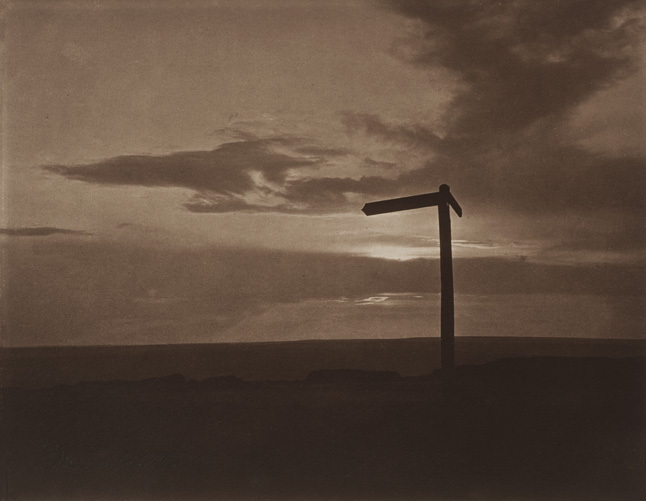Inventing Modernism – ‘Quo Vadis?’ by Frank Meadow Sutcliffe -American Museum of Photography

Frank Meadow Sutcliffe (England, 1853 – 1941): “Quo Vadis?” Van Dyke Brown print, date unknown - Frank Sutcliffe is best known for his photographs of life along the docks and streets of Whitby, a seaside town in North Yorkshire. His works met with a great deal of acclaim; Sutcliffe was awarded more than sixty medals for his photography during the latter part of the 19th century. In 1892, he was a founder of The Linked Ring Brotherhood, a group of early modernist photographers intent on claiming a place for photography among the fine arts. “Quo Vadis?” is a striking departure from Sutcliffe’s best-known pictures, which often depict familiar genre scenes such as fishermen with their boats or farmers toiling in the fields.
According to The Photographic Journal (August 1942, p. 288), Sutcliffe took this photograph of a signpost on the moor to please his wife – as he did not think it worth the cost of the photographic plate needed to make it. But “Quo Vadis?” became his second best-selling image.
This print is signed on both front and back, and carries the title in a bold ink inscription on the reverse as well; it may have been intended for exhibition. An unusual photographic process called Van Dyke (or Van Dyke Brown) was used to make the print; the process utilizes both iron and silver compounds and is capable of a wide tonal range, much like that of a platinum print.
Sutcliffe has made good use of this wide range of tones; despite the dramatic light in the cloud-filled sky, the sign can not be read, and there is only the slightest hint of a path on the ground. The photograph can easily be seen as a metaphor for the times in life when we are confronted by a crossroads and can not know which direction to choose.
The photograph may have been taken around 1896, when Henryk Sienkiewicz’s historical novel Quo Vadis: A Narrative of the Time of Nero was first published in book form. The novel was an important factor in the selection of Sienkiewicz as the 1905 Nobel Laureate for Literature.
“Quo vadis?” is Latin for “Where are you going?” and refers to a New Testament verse (John 13:36), “Simon Peter said unto him, Lord, whither goest thou? Jesus answered him, Whither I go, thou canst not follow me now; but thou shalt follow me afterwards.”
It is, however, a different story — one from the Apocrypha — that features in Sienkiewicz’s book. An aged St. Peter is preparing to flee Nero’s persecution of the early Christians when he is met along the road by a vision of Jesus. “Quo Vadis, Domine?” asks the aging Apostle, “Where are you going, master?” Jesus answers, “As thou art deserting my people, I go to Rome to be crucified, for the second time.” These words inspire Peter to turn around and head towards Rome, to face his own martyrdom.
Did Sutcliffe intend for this photograph to have a religious meaning? Certainly “Quo Vadis?” is open to many symbolic interpretations and perhaps that is its genius.
- Frank Sutcliffe is best known for his photographs of life along the docks and streets of Whitby, a seaside town in North Yorkshire. His works met with a great deal of acclaim; Sutcliffe was awarded more than sixty medals for his photography during the latter part of the 19th century. In 1892, he was a founder of The Linked Ring Brotherhood, a group of early modernist photographers intent on claiming a place for photography among the fine arts. “Quo Vadis?” is a striking departure from Sutcliffe’s best-known pictures, which often depict familiar genre scenes such as fishermen with their boats or farmers toiling in the fields.
Digital reproduction by R. H. Hensleigh. Thanks to Clayton Lewis, The William L. Clements Library for research assistance.Copyright © MMIX The American Photography Museum, Inc. All Rights Reserved. “American Museum of Photography” and the logo are Service Marks of The American Photography Museum, Inc.